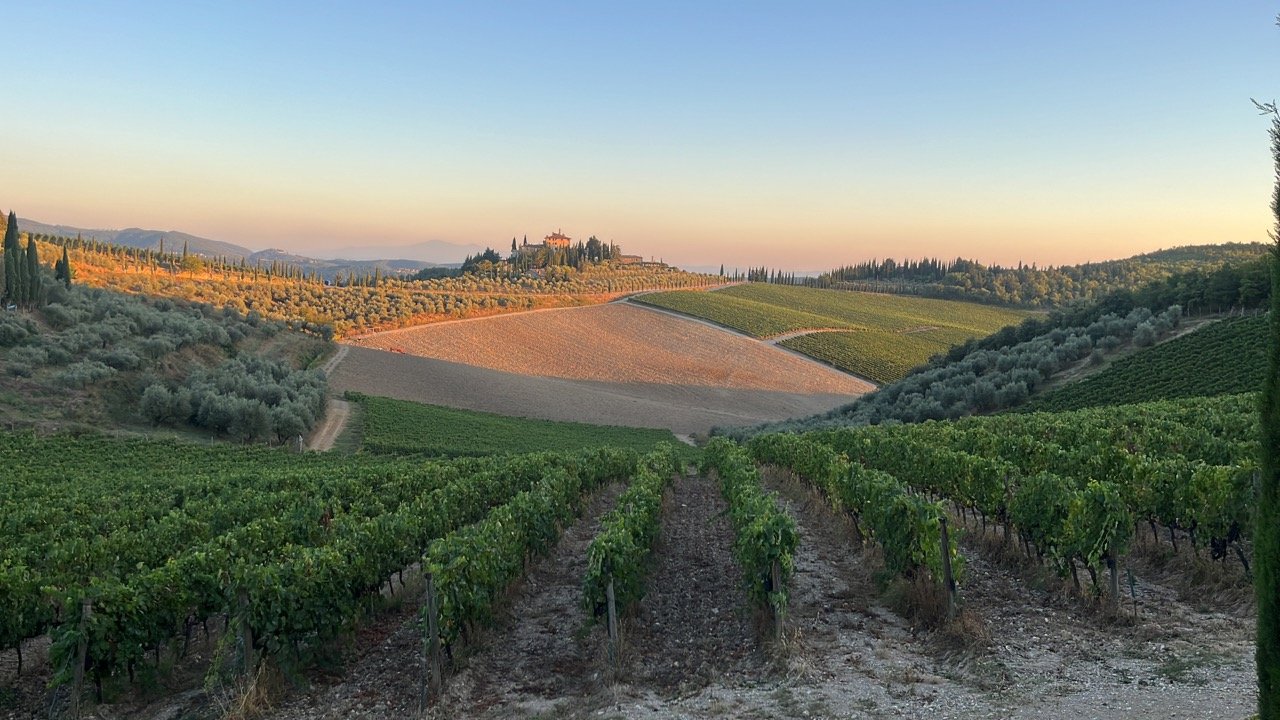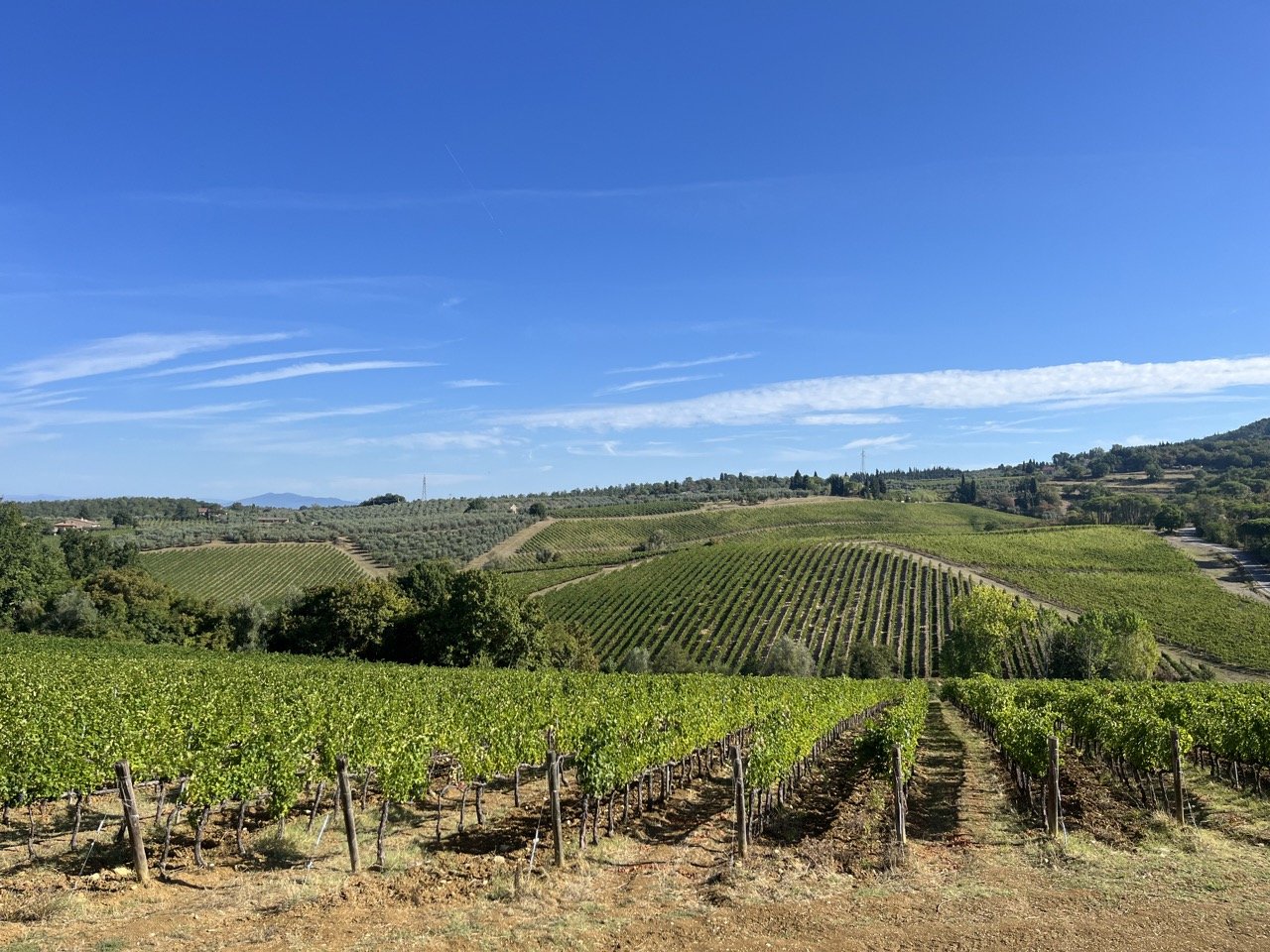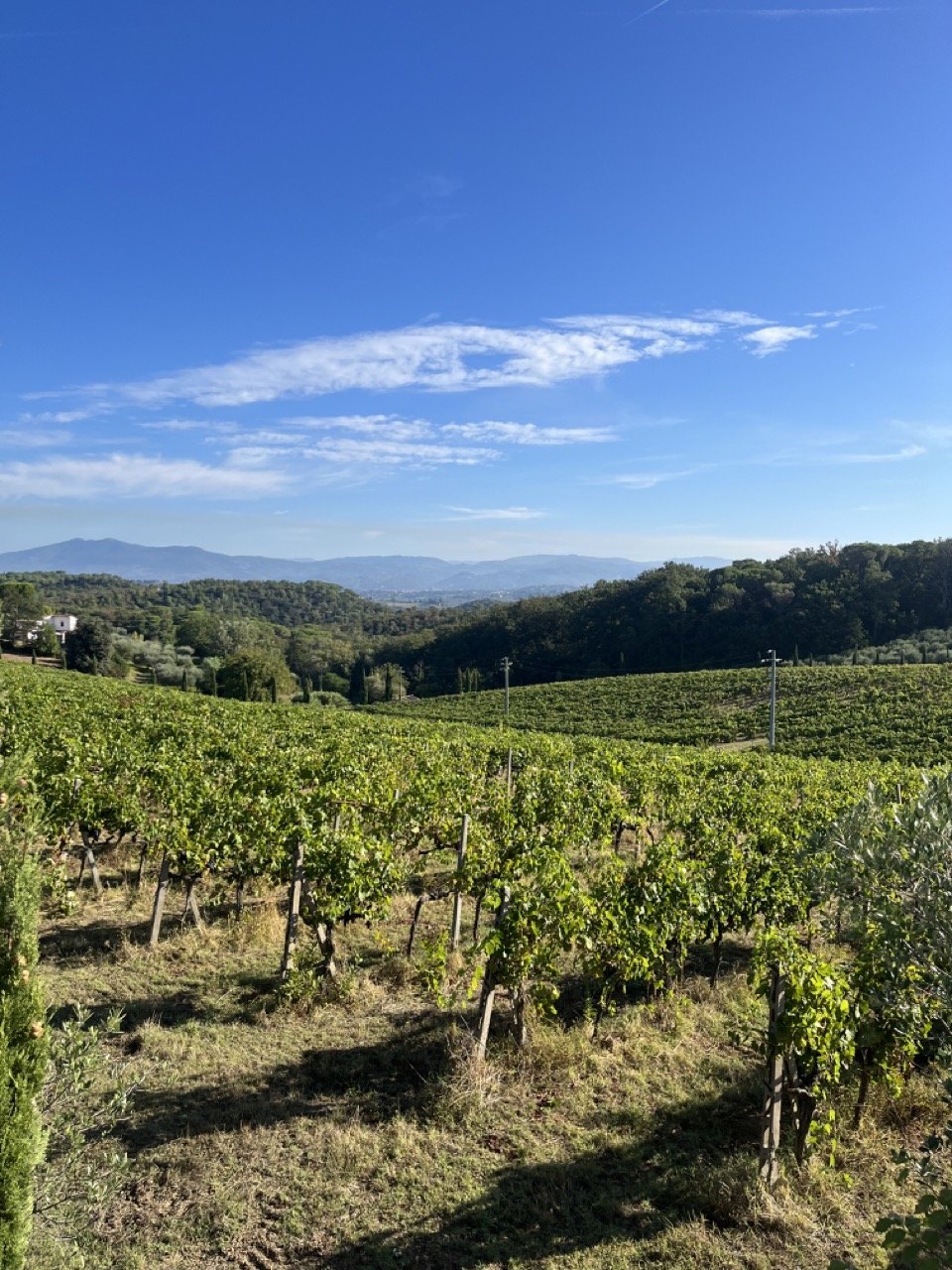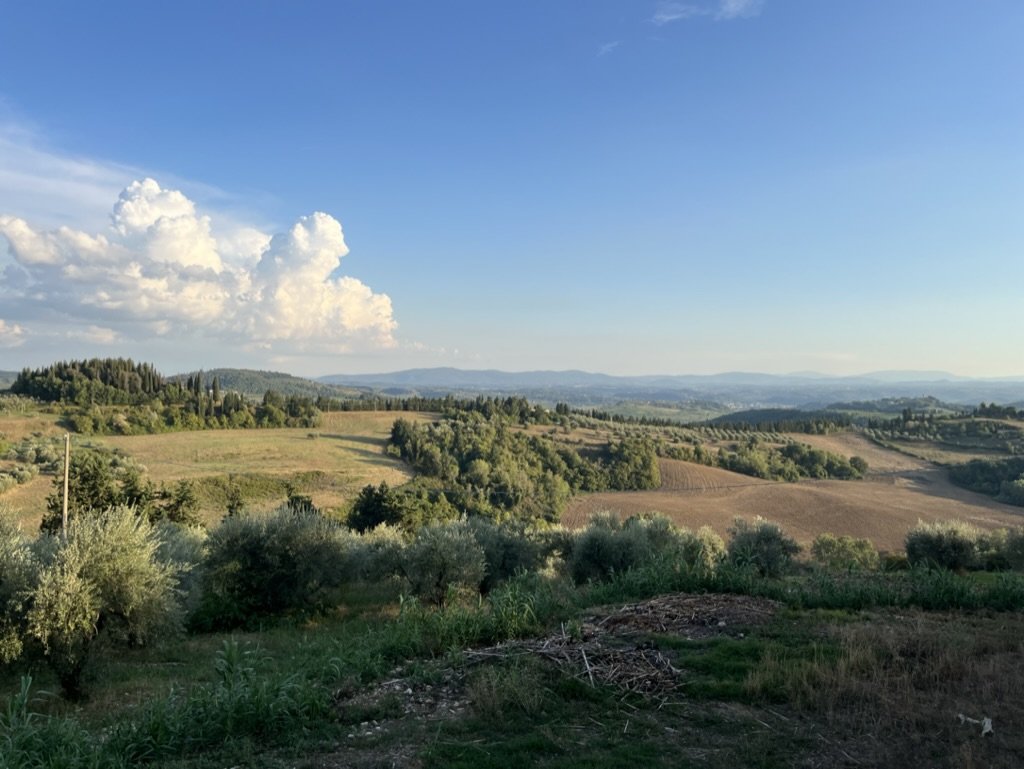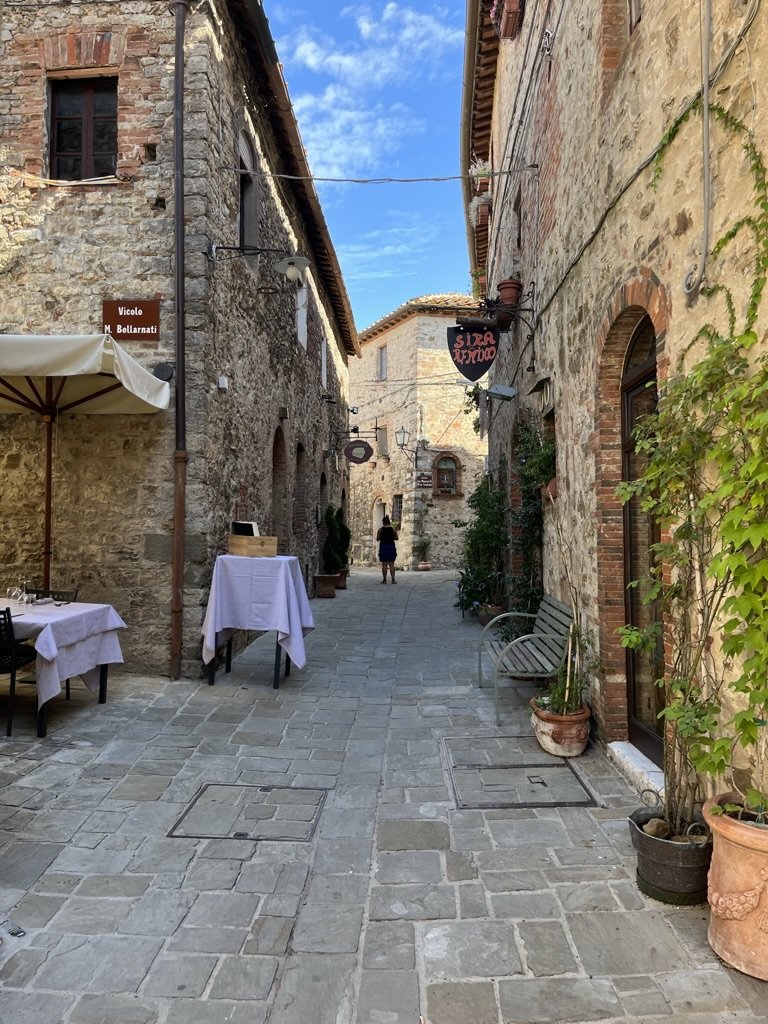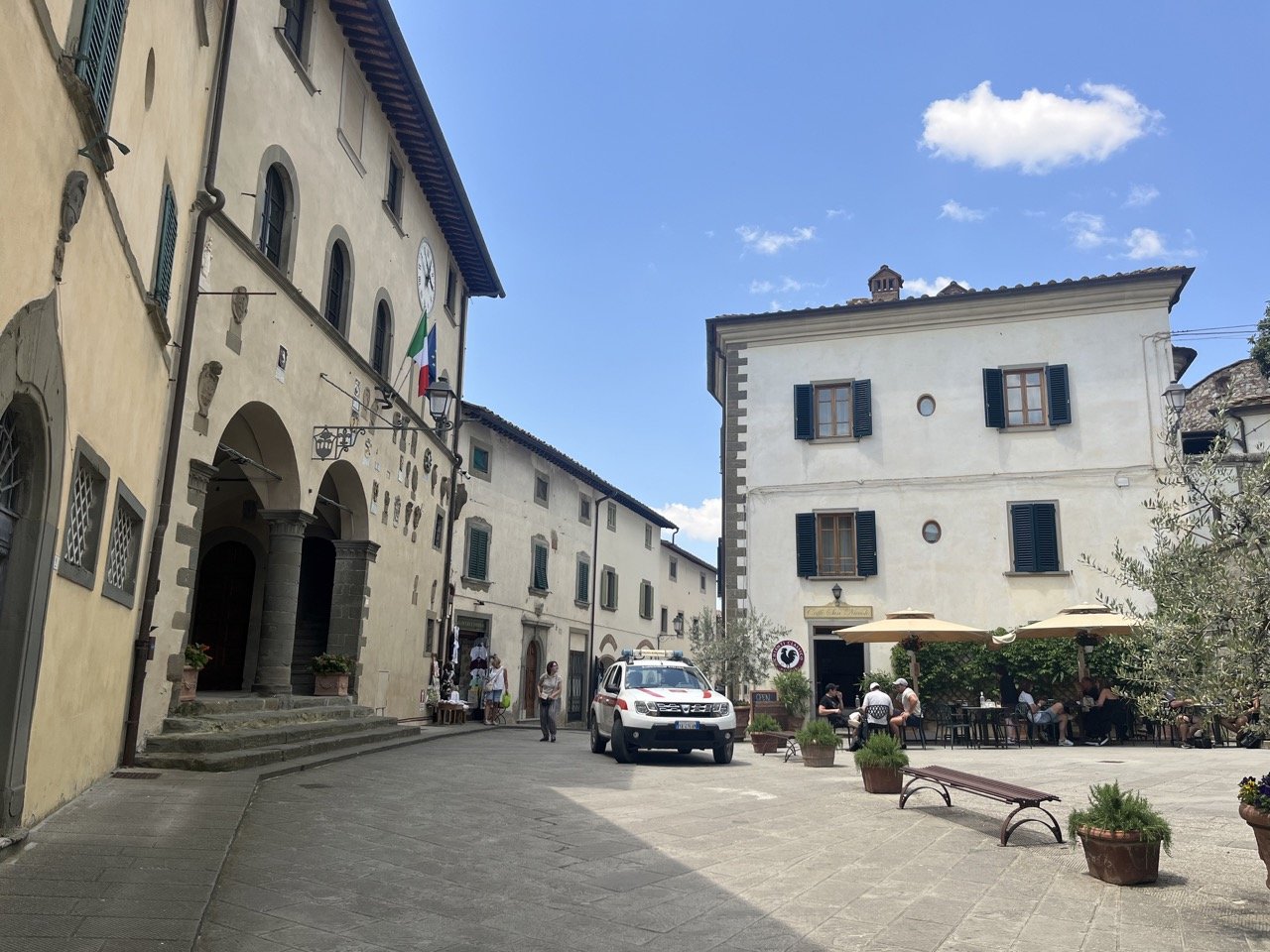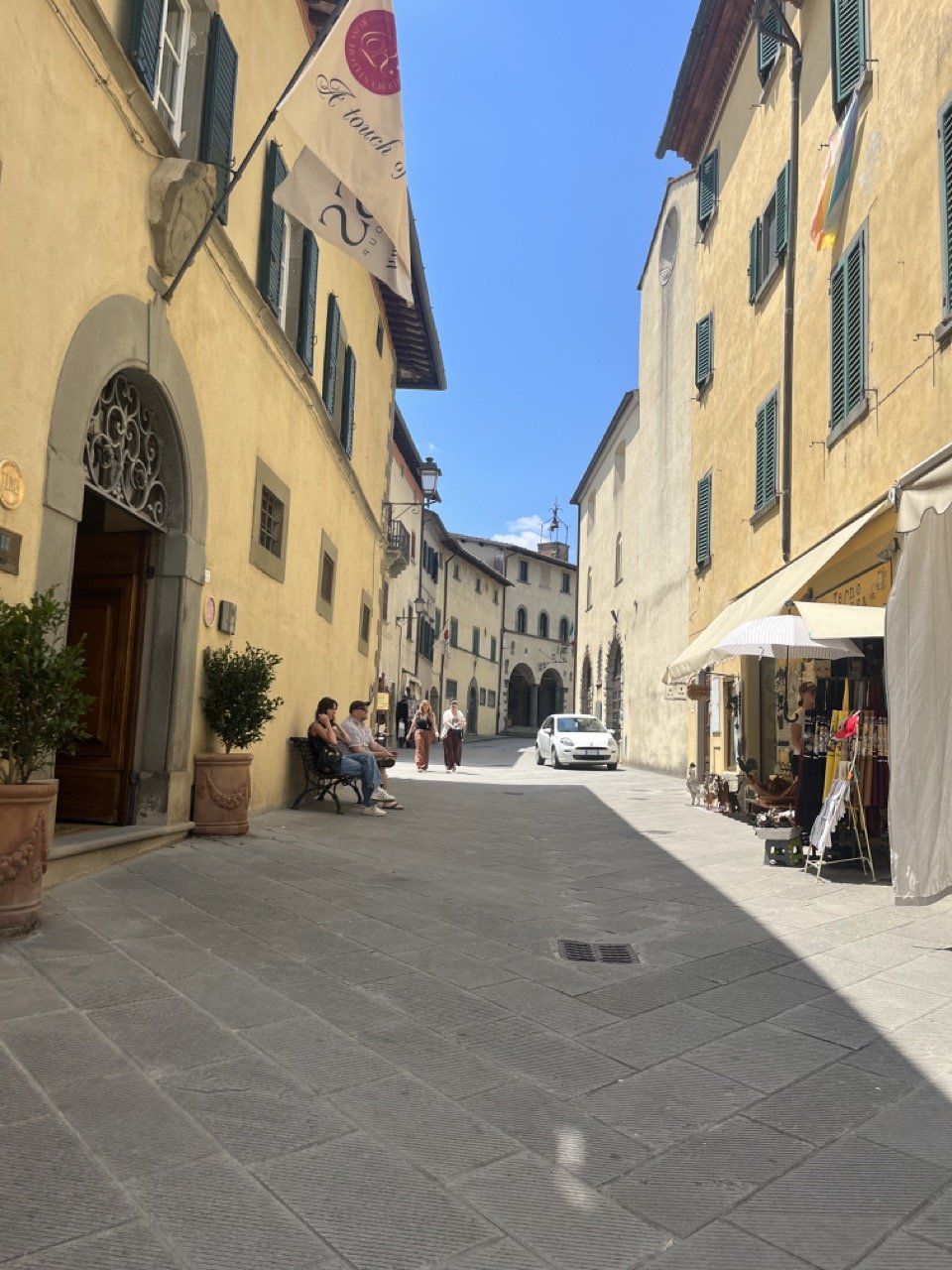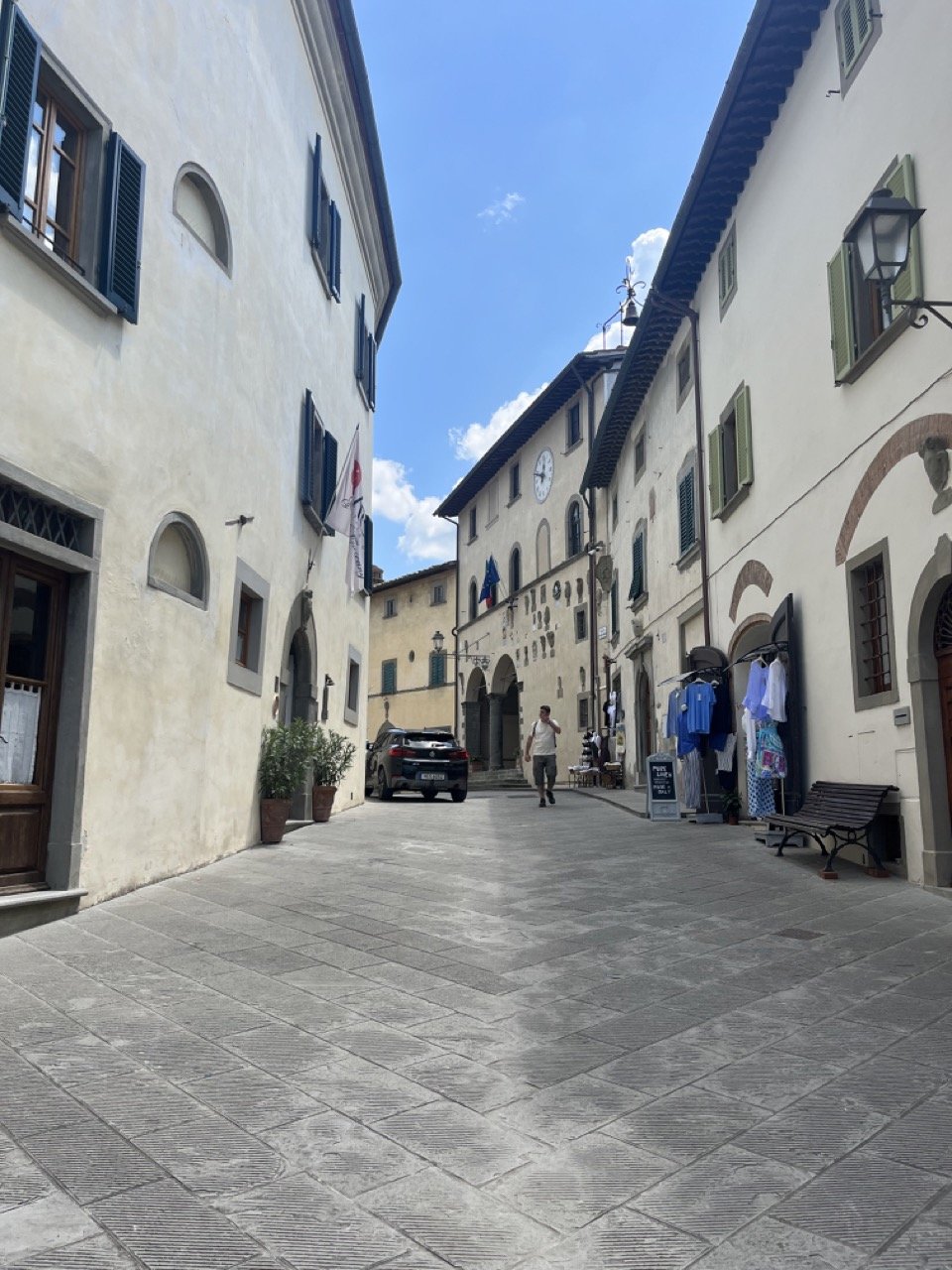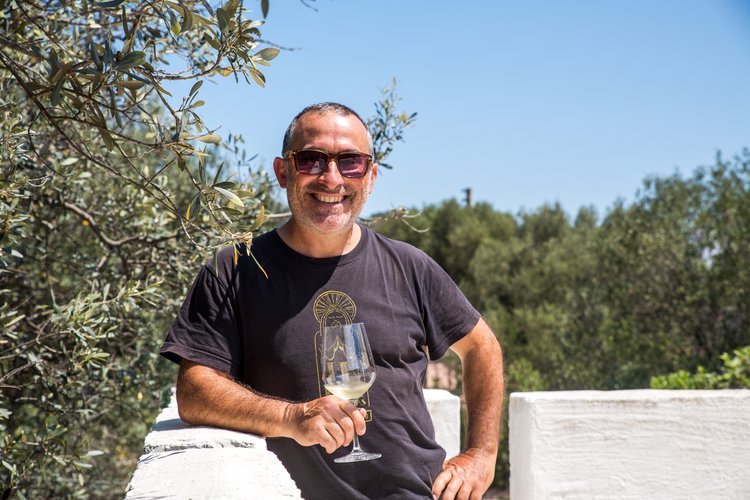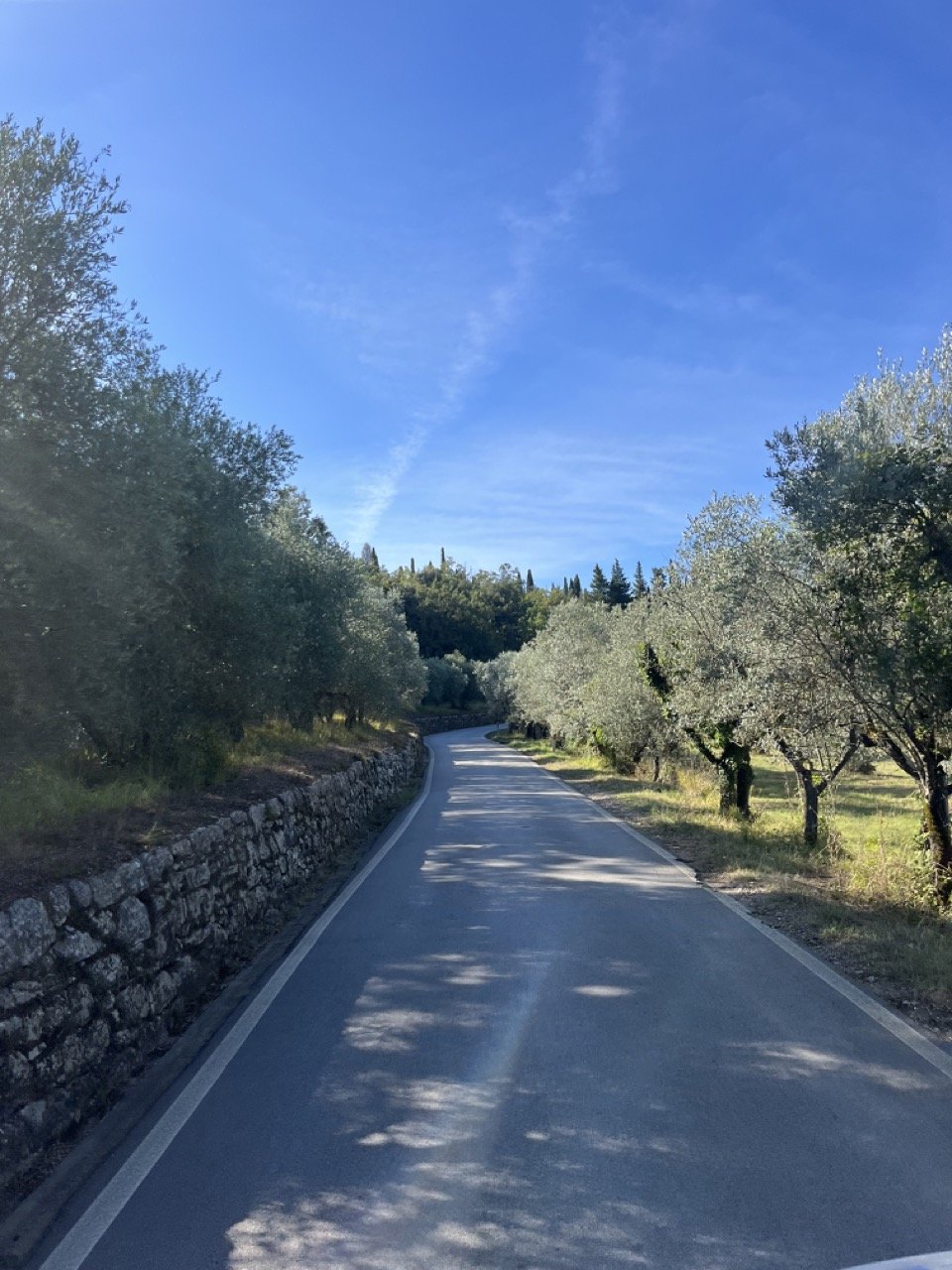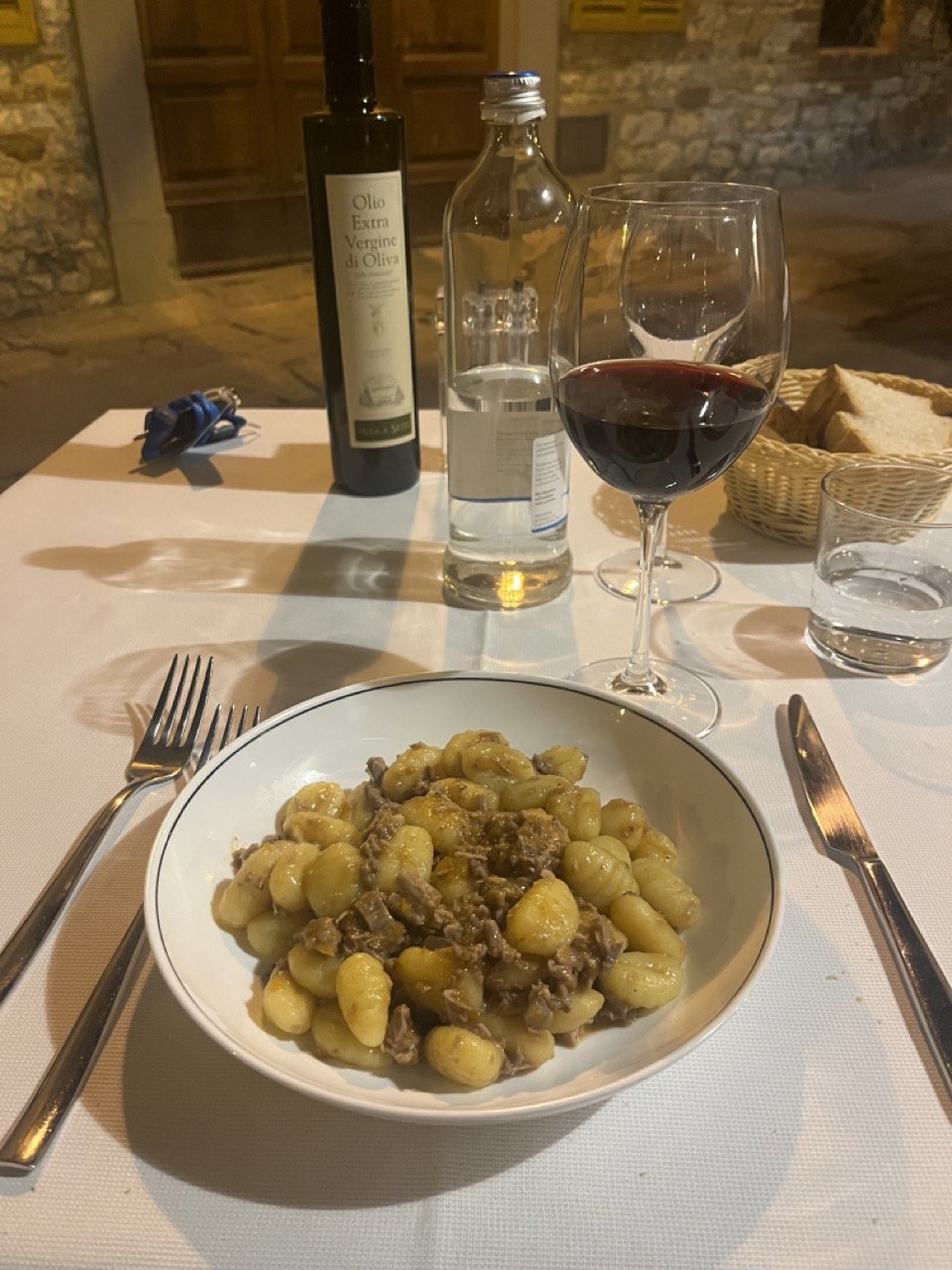Guide to Chianti, Italy - Tuscan Wine Country
Affiliate disclosure: some of the links in this article are affiliate links. If you book using one of them, we’ll earn a small commission. All of our info is free to read and free of ads, so we appreciate it!
Chianti is a scenic and mountainous wine-growing region comprised of 8 little towns in the heart of Tuscany. Tucked between two of the most remarkable cities in the world, Siena and Florence, beauty abounds here, wine flows, and every visit reminds you why you should come back before you’ve even left.
If there’s one thing I’ve learned over many years, it’s that it would be hard to find a nicer place on the planet to spend time.
Chianti is both the name of the region and the local wine produced here. But it’s not just any wine that puts this little region on the map; the region’s vineyards produce some of the world’s most esteemed wines, Chianti Classicos, made from the Sangiovese grapes that grow around such noted wine towns as Radda in Chianti, Greve in Chianti, Gaiole in Chianti, and Castellina in Chianti.
Even visitors without a taste for wine-touring are always delighted by the miles of rolling vineyards, stately olive groves, and handsome stone villages that are enticing draws for Italians and foreigners alike.
Table of Contents
Tuscany planning cheatsheet
 Plan your itinerary with expert advice
Plan your itinerary with expert advice
- Book an Italy travel consultation with a local expert
 My favorite hotels in Tuscany
My favorite hotels in Tuscany
- Hotel Calimala - Gorgeous boutique hotel in Florence's historic center. $250-450 USD
- Locanda de Ciomp - Excellent value guesthouse in Florence. $150-200 USD
- Palazzo Ravizza - Lovely midrange option in Siena. $120-175 USD
- Castello di Fonterutoli - Delightful castle & winery resort in the Chianti countryside. $200-300 USD
- Meublé il Riccio - Historic property in the heart of Montepulciano. $160 USD
- La Casa Di Adelina - Charming B&B in the Val d'Orcia village of Montichiello. $130 USD
 Guided tours and activities
Guided tours and activities
 How to get around
How to get around
- Car rentals with DiscoverCars
- Train tickets from Trenitalia and Italo
- Bus routes via Autolinee Toscane, Sitabus, and Flixbus


What is Chianti?
The Chianti region is a small sub-region in Tuscany, famed for its production of Chianti Classico wines made from the local Sangiovese grape.
While not an official region, province, or administrative area, Chianti is defined by the vine-covered hillsides that surround eight little towns located between the cities of Siena and Florence. It is a rural and sparsely populated agricultural area.
Although the definition of Chianti has changed over time and many nearby locations now try to cash in on its fame by also claiming to be part of the Chianti region, officially it is comprised of just the following eight towns: Barberino Val d’Elsa, San Casciano in Val di Pesa, Castelnuovo Beradenga, Castellina in Chianti, Gaiole in Chianti, Greve in Chianti, Panzano in Chianti, and Radda in Chianti.
The 5 towns whose names end with “in Chianti” are sometimes referred to even more specifically as the “Chianti Classico” area. This even smaller area is regarded as the heart of Chianti.
Both historically and still today, some of these towns fall under the administration of Florence, while others are part of the province of Siena.
The name Chianti first appeared on maps in the 13th century, when Florentine officials established the Lega del Chianti, a military confederation meant to secure the territory around present-day Radda in Chianti, Castellina in Chianti, and Gaiole in Chianti. Historically, the mighty city states of Siena and Florence fought over the region, each fiercely defending their territory. These days, the only fighting left is between fans of the two local soccer teams, with half the region cheering for Siena and the other for Fiorentina (though it’s not much of a contest anymore…).
The Chianti Classico producing region as we know it today was demarcated by Cosimo III de’ Medici , Grand Duke of Tuscany, in 1716.
The largely rural area has not changed much over the centuries and is covered in a mix of oak and chestnut forests, olive groves, and, of course, vineyards, while small towns and villages command many of the hilltops.
Wine-growing is still the major component of the local economy, alongside the production of olive oil and tourism.
For more info on wine in Tuscany, have a look at our guide to Tuscan wine and our guide to wine and wineries in Chianti.
Where is Chianti
Chianti rises and falls over hilly terrain between Florence, to the north, and Siena, to the south. To the east, the hillsides carpeted with vineyards and olive groves overlook the Val d’Arno, and to the west, the Val d’Elsa, two Tuscan valleys.
Arch-rivals Florence and Siena fought over the region for centuries, and towns still fall under the influence of one or the other. Greve in Chianti, for instance, is part of Metropolitan Florence, while Gaiole in Chianti is in the Province of Siena.
These administrative distinctions aside, the towns of Chianti are all within easy reach of both Siena and Florence, and of each other. Greve is only 30km (18.5 miles) south of Florence and 40km (25 miles) north of Siena, while Gaiole is 40km (25 miles) southeast of Florence and 15km (9 miles) northeast of Siena.
How long to spend
You can get a taste for Chianti on a day trip, and many visitors content themselves with a quick drive through the region along the Chiantigiana road between Florence and Siena, maybe stopping for some wine tastings and a meal. However, this doesn’t do the region justice.
For a good visit to Chianti, you should spend at least a few days here to savor the beautiful rolling hills, and explore the region’s excellent hiking, gravel bike trails, pretty vineyards, and meandering country drives. Many of the towns are rewarding, too, though most are small and easily explored in an hour or two.
As you get to know the region, you’ll discover that this beautiful corner of Tuscany is ideal for a long stay of a week, a couple of weeks, or even months. In fact, so many British vacationers have fallen under the spell and bought houses here that the region is often called “Chiantishire.”
Chianti also makes for a good base from which to explore much of the rest of Tuscany. Most Chianti towns are 30 to 60 minutes from Florence and more or less the same distance from Siena.
You can get over to the Val d’Orcia and such noted hill towns as Montepulciano and Cortona in around an hour and a half, or travel west to Volterra in an hour and from there on Tuscany’s lovely Maremma coast.
Places to visit
There are eight major towns in the Chianti region. Most are very small, and many are quite pretty. While it’s a pleasure to stroll around some of these towns, admiring the squares and stone houses, you won’t find a lot to do in them. The main appeal of this region lies in the beautiful landscapes.
As you explore, you’ll see road signs leading to such hamlets as Vagliagli, San Sano, San Gusmé, and Castagnoli. These are called “frazioni” and would once have been independent towns, but have long since been incorporated into larger nearby municipalities. Nonetheless, they have the feeling of being separate villages and make for lovely wanders.
1. San Casciano in Val di Pesa
One of the larger towns in Chianti, with about 18,000 residents, San Casciano is just 20 minutes outside of Florence. It’s a work-a-day place with lots of businesses that serve the farmers and wine makers based outside of town.
There’s little to see and the main attraction is the countryside around it, but if you find yourself passing through, you have a few good restaurants and a handful of cafes and gelato shops that reward a stop.
For a terrific meal with a fabulous view, about 10 minutes outside of town is the splendid restaurant La Capanna del Gallo.
The famous Antinori winery is nearby too, and they do tours and tastings practically every day of the year.
The road that leads from town to the little hamlet of Montespertoli is also very scenic.
Vineyards just outside of San Casciano
More vineyards!
A cafe in San Casciano
2. Barberino Val d’Elsa
Barberino is a bit off the beaten track at the western edge of the Chianti region, but still just a half hour from Florence. It’s now part of a “twosome” since it merged with the adjacent town of Tavernelle Val di Pesa to form a single municipality.
Barberino is essentially two streets, but they’re very pretty. Perched high on a narrow hill, the views in every direction are fantastic. Within eyesight of town is the remarkable Badia a Passignano, an abbey from the 11th century.
For a really unique winery tour, take one of the dirt roads on the edge of town that leads into the woods. Your destination is Fattoria Le Masse an organic and biodynamic winery run by Robin and Cecilia, a young couple who love what they do and have a property that is historic, rustic, and very different from the more industrial wineries you’ll see elsewhere. The views are also great.
Countryside outside of Barberino
Fattoria Le Masse winery in Barberino
Fattoria Le Masse winery in Barberino
3. Castelnuovo Beradenga
With about 10,000 residents, this town almost within sight of the towers of Siena is one of the larger wine centers of Chianti. Even so, it’s a quiet place with few landmarks and an easygoing, low-key charm.
There are no specific sights, but part of the town is walled and inside is a pretty little center that’s nice to walk through. I always stop for a coffee at Bar Centrale.
If you’re hoping to do some cycling while in the region, you can rent bikes at Chianti Bicycles which is on the main road just outside the walls.
10 minutes from Castelnuovo and heading deeper into the hills is the tiny village of San Gusmè. I think it’s one of the prettiest places in Chianti. It’s walled, all stone, pedestrianized, and on the top of a hill offering ridiculous views.
The fields around Castelnuovo Berardenga seen from San Gusmè town
San Gusmè
San Gusmè
4. Castellina in Chianti
This lovely little village of less than 3,000 residents is clustered around the large castle the Florentines built to hold off incursions by Siena, which sits just 35 minutes south.
Wine and food shops line the main street, Via Ferruccio, which is closed to cars, and the most atmospheric walk in town is along the Via delle Volte, an underground passageway inside of the city walls that was once a defensive lookout and from which you can enjoy views over the countryside.
There are lots of good restaurants, cafes, enoteche (wine bars), and a few little shops.
Castellina’s church
A street in Castellina
Via delle Volte within the city walls
5. Gaiole in Chianti
This little town, about 30 minutes from Siena and home to fewer than 2,000 residents, surrounds a lovely triangular square lined with several shops and restaurants. The famous gravel bike race L’Eroica starts and ends here each October and attracts amateur cycling enthusiasts from around the world.
You can follow the paths any time of year on bikes and e-bikes available for rent. For rentals, reach out to the people at Il Biciclettaio right in town.
Gaiole is deep in the woods and hills, so the surrounding terrain is different from a lot of what you see elsewhere in both Tuscany and Chianti. You’ll still find lots of vineyards, but you’ll also be in dense forest. It feels markedly wilder here and less manicured than the rest of the region.
It’s the perfect area for peaceful walks in the woods, mountain biking, cycling, and quiet drives on twisting and empty roads that are almost always lined by woods, vineyards, and olive groves.
The town is also home to one of my favorite restaurants in the region, the unpretentious and almost impossibly good La Gorgia.
Nearby you have all sorts of wonderful places to visit: Castello di Brolio castle and winery (among many great wineries), the pretty hamlets of Volpaia and San Sano, the Chianti sculpture park, and much more.
Driving or biking in any direction invariably leads you to the best view you’ll have ever seen (until you come across the next one).
The outrageous view from my favorite spot in the hills above Gaiole
Gaiole’s main street
Dinner service at La Gorgia
Castello di Brolio seen from the backroad that goes to Monti
6. Greve in Chianti
This longtime center of the local wine and olive-oil trade, a little over half an hour from Florence and 40 minutes from Siena, Greve is the unofficial capital of Chianti and home to about 14,000 residents.
At the heart of town is a large square (actually, more of a triangle). You’ll notice that the arcades that surround the square are a bit of a mishmash; that’s because over the centuries merchants have been responsible for building the stretches in front of their shops, and have done so without much concern for uniformity.
From spring to the end of fall, a great farmers market is set up in the main square on the 4th Sunday of every month.
Most businesses in town are wineshops and enoteche (wine bars), including the excellent Bottega del Chianti Classico.
Nearby, the hamlets of Lamole and Montefioralle are lovely and very much worth visiting. The Castello di Verrazzano is an impressive winery you can tour as well.
Montefioralle, just 15 minutes by foot from Greve, deserves its own special mention. This tiny and atmospheric village with fewer than 100 residents is entirely enclosed within its medieval walls and you may be the only visitor in town. While there, be sure to stop by the home with the wasp above the door and marked by the number 21. It’s said to have been the family home of Amerigo Vespucci, the explorer who lent his name to the new world.
Since Greve is one of the larger towns of the region, I often recommend it as a good base.
An event in Greve’s main square, Piazza Matteotti. Photo: Repuli, CC BY-SA 4.0, via Wikimedia Commons
The hamlet of Montefioralle. Photo: Mauro De Carvalho, CC BY 2.0, via Wikimedia Commons
7. Panzano in Chianti
Commanding a hilltop about halfway between Florence and Siena, this now quiet village with just 1,100 residents saw centuries of strife, as the city walls and ruins of a once mighty castle will attest.
Aside from soaking in the medieval atmosphere, visitors also come to visit the beautiful Pieve San Leolino, a Romanesque church just outside the walls.
The town is also home to a very famous resident, the butcher and personality Dario Cecchini. His butcher shop (now also a restaurant, shop, and entire business operation), Antica Macelleria Cecchini, draws visitors from all over the world.
Panzano seen from outside of town. Photo: LigaDue, CC BY-SA 4.0, via Wikimedia Commons
Santa Maria Assunta church. Photo: Peter K Burian, CC BY-SA 4.0, via Wikimedia Commons
Countryside near to town. Photo: Saliko, CC BY-SA 4.0, via Wikimedia Commons
8. Radda in Chianti
This quiet little town of just 1,500 residents once loomed large, when Florentines established it as head of the Lega del Chianti in their effort to protect the area from Sienese control. Remnants of the time are a circuit of thick city walls and the Palazzo del Podesta, the impressive government building built in the 1500s.
Aside from following the medieval lanes, the pleasure of exploring Radda is enjoying the views over the surrounding countryside.
There’s nothing specific to see, but it’s pretty and always busy and lively. It’s a nice place to stop at, grab a coffee, go for a stroll, and do some people watching. There are also some stores selling touristy stuff and a few decent wine bars.
A square in Radda
Radda’s main street
Same street…
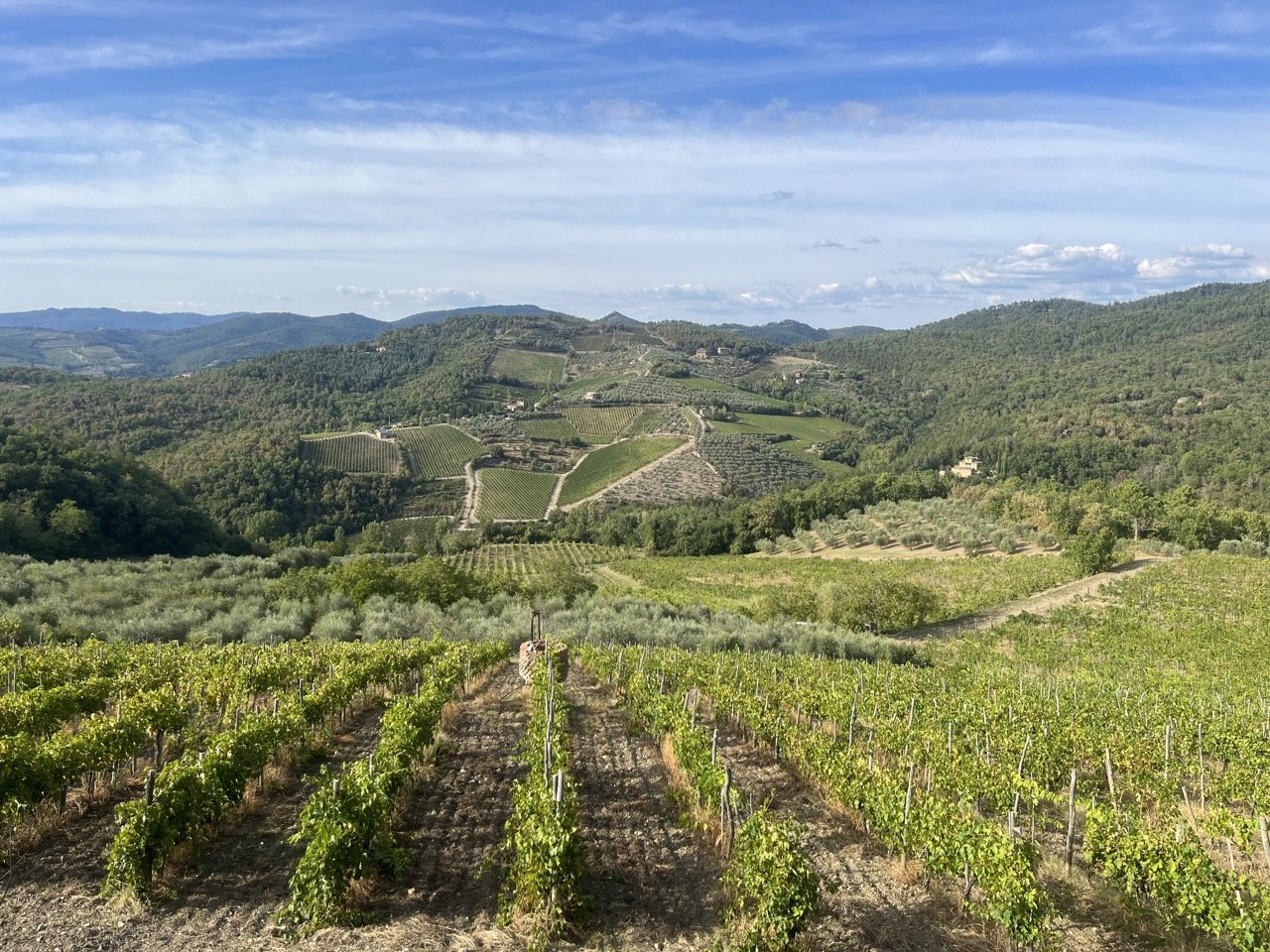
Things to do in Chianti
1. Taste wine in a castle
Wine, of course, is what brings many visitors to the region, and some 300 wineries produce Chianti Classico, following rules and regulations that earn them the Denominazione di Origine Controllata e Garantita (DOCG), the highest designation for Italian wines.
Many wineries offer tastings in beautiful tasting rooms and many often also operate roadside stands that make it easy to stop for quick tastings as your designated driver follows the Chiantigiana road.
The most evocative wineries to visit are those that occupy castles that have been the center of wine-growing estates since the Middle Ages. Among them is the oldest winery in the world, Ricasoli, established in 1141 at Castello di Brolio outside Gaiole. Here in the mid-19th century Barone Bettino Ricasoli came up with the blend for the region’s acclaimed Chianti Classico wines. Tours include a walk along the ramparts, with views across miles of vineyards and forests of oak.
Americans might feel a special affinity at the Castello di Verrazzano, birthplace in 1485 to the explorer who discovered New York Bay and whose image appears on the labels of the estate’s acclaimed wines that are stored in the centuries-old cellars.
Walls and towers of the 11th-century Castello Vicchiomaggio remain, along with a splendid Renaissance manor at which Leonardo da Vinci was once a house guest. You are welcome to visit these and other castle-wineries even if you are not tasting wine, and it’s a pleasure to walk around the grounds and admire the architecture and the views.
Many of the region’s castle estates also accommodate guests and have restaurants.
For more info on wineries in Chianti, check out our guide to wine touring in Chianti.
For a great private wine tour of Chianti’s towns and vineyards, connect our favorite local guide Stefano offers 3 very cool options:
a luxury wine tour by car
a walking winery tour that includes beautiful walks/hikes in, around, and between the vineyards
an e-bike wine tour where you cycle between wineries
2. Stroll through pleasant stone villages
Rising above the vineyards and olive groves are dozens of stone, tiled-roofed villages. Almost all of them warrant at least a quick stroll.
A stop I always make when showing friends around the region is Panzano, hard to beat for its medieval atmosphere and the views across the hillsides from the city walls.
Montespertoli is another charmer, set on a hillside above a patchwork of fields and vineyards with a medieval castle that was once the stronghold of the Machiavelli family.
Montefioralle is also magically atmospheric, surrounding a castle keep, with a double-circuit of medieval walls that still make an appearance here and there.
Volpaia and San Gusme are two other charmingly medieval fortified villages still enclosed within their walls.
Castellina is a little collection of stone houses that huddle beneath a formidable fortress, or Rocca, and one street, the underground Via delle Volte, actually tunnels beneath a length of the city walls.
3. Spot the black rooster
Florence and Siena fought over lands in the Chianti region for centuries and, legend has it, finally decided to end the dispute by setting a firm boundary. Each city would send a knight on horseback into the territory at the first crow of the rooster, and the point where the knights met would be the border.
Crafty Florentines starved their black rooster so he awoke early, cranky and hungry, crowing like mad, while the well-fed white Sienese rooster slept until much later. So the Florentine knight made it almost to Siena, to Castellina, before he encountered his Sienese counterpart, and hence Florence got the lion’s share of the land.
Today you’ll find the Black Rooster on the emblems of municipalities, on banners, on tee-shirts, in the guise of a statue in the center of Gaiole, and most notably, on bottle labels, to indicate that the wine is of authentic DOCG Chianti Classico designation.
4. Shop at local markets
You’ll come upon markets with stalls selling cheese, salami, fresh fruit and vegetables, and wine, of course, along with locally made ceramics and other wares, in Strada in Chianti every Tuesday, morning, and in Greve, Panzano, and Castellina every Saturday morning. You’re likely to find markets in other small villages as well.
Montespertoli stages a huge Chianti exhibition in late May and early June, though many villages wait to fall to celebrate the harvest with wine festivals and exhibitions to show off the vintages, with the largest, the Rassegna del Chianti Classico, in Greve. You should also check out the cozy Christmas market there if you’re in the region in December.
5. Take a hike
A gentle walk is the most idyllic way to see the region, especially if it includes a stop for a snack and glass of wine. A network of strade bianche (gravel routes) laces the region and are ideal for hiking. Well-marked routes surround most of the towns, and you can get a list of them from local tourist offices and from the regional Chianti tourist administration at www.visitchianti.net.
My favorite amble is from Greve out to Panzano and back, with plenty of shade and passing some nice stretches of woodland as well as the village of Montefioralle. The roundtrip covers about 14km (about 8 1/2 miles), mostly on gravel roads, and you can halve the mileage by turning back to Greve in Montefioralle.
6. Visit the region’s interesting little museums
One of my bad-weather fallbacks when showing friends around is the Museo Archeologico del Chianti Senese in Castellina. The best part of a visit is wandering around the atmospheric medieval fortress that houses the exhibits, some of the most intriguing among them being the vessels the Etruscans who lived in these parts before the Romans used to store wine in 2700 b.c.e.
None of the art in the region even comes close to the masterpieces you’ll see in Florence and Siena, but the Museo d’Arte Sacre di San Francesco in Greve houses a small but worthy collection of paintings and a visit ends on a breezy terrace with views over the countryside.
A wine tasting at the Enoteca Falorni in Greve can include a stop at their Museo del Vino, where old wine implements fill old cellars and more than 1,000 hams hang in the adjacent prosciutto cave, slowly seasoning in the dark, cool, and fragrant surroundings.
It only makes sense that these landscapes would be the backdrop for transporting art into nature, and that’s precisely what they’ve done on the grounds of the Chianti Sculpture Park near Vagliali.
My favorites among the works by international artists are those fashioned from glass, including one that resembles a giant cypress tree, a maze constructed from glass blocks, and a whimsical rainbow made of Murano glass.
7. Go for a bike ride
The roads in Chianti are blissfully quiet and, aside from the main roads, mostly free of heavy traffic, so a bike ride is a great way to spend a day. There’s also a good network of strade bianche (gravel routes) for riders who want to get off the asphalt and plunge into the countryside.
Gaiole in Chianti is the start of the October L’Eroica gravel-path bike race, and at any time cyclists can follow well-marked routes of 46km (28 ½ miles) and 81km (50 miles) that pass through some of the most scenic Chianti countryside and villages.
Bike and e-bike rentals are available in Gaiole (and in most other towns as well), and shops are usually eager to offer route suggestions.
8. Admire the views
Great views are common currency in this part of the world, and the higher up you go, usually the better. One of my favorite outlooks is from Castagnoli, a hilltop hamlet surrounding a somber stone rocca, fortress, outside Castellina.
The views take in not only the terraced vineyards that drop away beneath your feet but extend far west across forests and hills that roll toward the horizon. Lamole is another scenic, view-filled spot, high up in the hills at the end of a cypress-lined road between Greve and Panzano.
9. Stop in little hamlets along the SS222 road
A drive along the Chiantigiana (SS222) between Florence and Siena displays beautiful scenery and enticing towns, but a few detours show off even more of this scenery-rich region.
For starters, on the short drive from Greve to Panzano, take the turnoff onto a narrow, cypress-lined road up to Lamole, for fantastic views. The SS222 rises and falls through vineyards and olive groves for 16km (10 miles) from Panzano to Castellina, and from there you can plunge east through the vineyards on the narrow SR429 to Radda.
That’s a good jumping-off point to the little village of Volpaia, just 7km (4 miles) north, and you can make a loop south through San Sano to Gaiole, 14km (9 miles) southeast.
Wherever you wander in Chianti, it’s usually pretty easy to get back to the starting point. From Gaiole, for instance, it’s only 30km (18 miles), or 35 minutes, back to Greve.
10. Make your own blend of wine
When you’re ready to go beyond a mere tasting, put yourself in the hands of the experts at Fattoria Viticcio outside Greve or Castello di Meleto near Giaole, both of which will help you create your own blends.
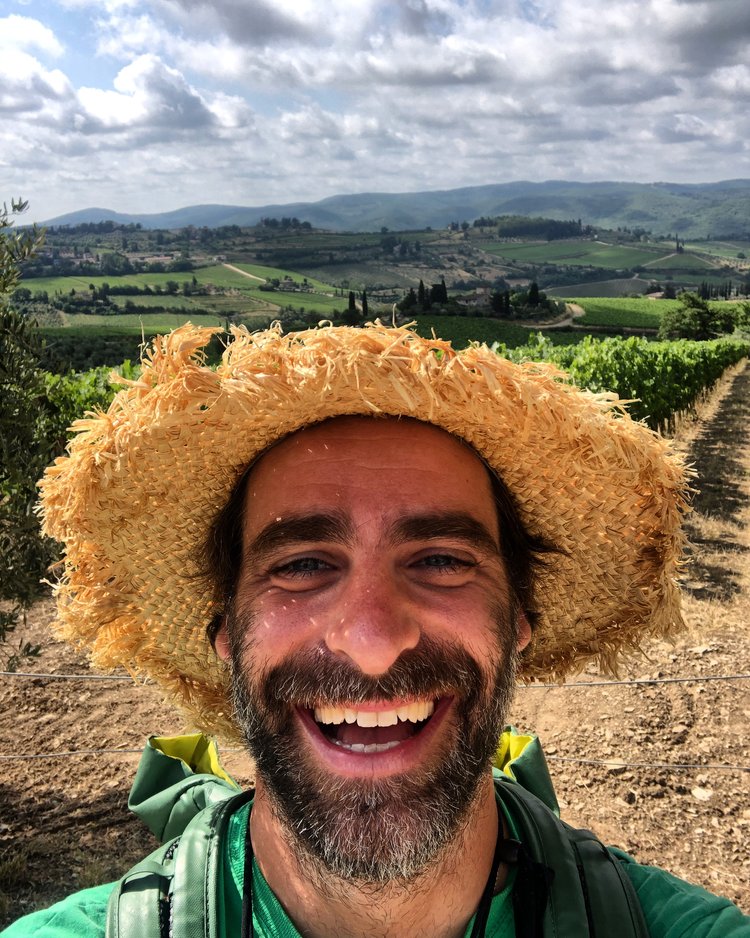

How to get around
If you’re arriving to Chianti from other parts of Italy or from farther afield, the most convenient gateway is Florence, with excellent train connections to all of Italy and an international airport. Visitors also often fly into Pisa which is just 69km (43 miles) away from Florence and connected to it by train, bus, and highway.
For getting to Chianti, the good news is that the main road through the region, the SR222, also called the Chiantigiana, is one of the most scenic routes in Italy, following gentle rolling hillsides for 60km (37 miles) between Florence and Siena.
The bad news is that the only easy way to travel this picturesque, two-lane byway is by car.
Public transport
First, know that there is no train service in Chianti. None of the towns have train stations and even Siena has very limited service.
While there is intermittent bus service that can get you to some of the Chianti towns from Florence or Siena, and between a few of them, it’s neither convenient nor frequent. And for a rural region whose charm lies in visits to the countryside, buses simply won’t get you to most places you’ll want to visit.
Getting around by bus is not a realistic option for most travelers, especially those with limited time.
From Florence, no local bus runs the entire route to Siena, and only a few Chianti towns are reachable. The 365A bus (direction Lucarelli) departs once per hour and stops in Greve and Panzano, as well as a few smaller villages. It takes about an hour to get to Greve. Buses leave from the Piazzale Montelungo station next to Santa Maria Novella train station on Viale Strozzi
From Siena, the Route 125 bus can bring you to Gaiole (30 minutes), Castellina (1 hour), and Radda (1.5 hours). It only runs 4 times a day though, so you’ll have to plan your schedule carefully. Buses depart from in front of the train station
For info on buses from Florence, go to www.fsbusitalia.it. For buses from Siena, go to www.at-bus.it.
By car
If you’re driving in Chianti, your main road will be the SR222, referred to locally as la Chiantigiana. It’s a very well maintained road that typically doesn’t have much traffic and the scenery along it is gorgeous.
If coming from Florence, you’d just take the A1 autostrada (highway) and then exit at the city’s southeastern edge onto the SR222. Getting from Florence to the Chianti towns takes from 30 to 90 minutes, depending on the final destination.
From Siena, the closest parts of Chianti are just 10-15 minutes away by car. Getting to the furthest reaches of the region could take an hour.
If you’re planning a road trip, know that driving the SR222 route straight from Florence to Siena would take you 1.5-2 hours. In practicality, it will take you much longer because you’ll certainly want to make lots of stops.
Where to rent a car
If you plan on renting a car, you’ll find all the major international rental agencies in Tuscany. That said, you won’t be able to rent a car in any of the Chianti towns themselves and you might not even be able to do so in Siena. You’ll probably want to pick up your rental in Florence (or whatever larger city you’re coming from).
To check prices and find a car, I always recommend using DiscoverCars. It’s a car rental website that includes offerings from all the major international rental companies as well as lots of smaller local agencies, which frequently have much better pricing. You can often find great deals.
Where to stay
The patio at Castello del Nero hotel in Barberino Val d’Elsa
The town or area where you choose to stay in Chianti is not a terribly important consideration, since in this small region most places are within easy reach of one another.
The Chianti towns are also very small, often just a few streets, and most of the accommodation options are actually in the countryside outside of them.
Many hotels have extensive grounds, often with swimming pools and other amenities, making Chianti an especially relaxing place to spend a warm-weather holiday, and it’s easy to use the rural surroundings as a base for exploring Florence, Siena, and other parts of Tuscany.
Your lodgings will most likely be loaded with character, since many are in old castles, manors, palaces, and farmhouses.
You’ll find accommodation at all different prices, ranging from 5-star luxury hotels (often with their own vineyards) to rustic, family-run B&Bs.
Here are some choices that show the range of accommodations available. Prices are per night for two guests.
Castello del Nero - Frescoes and other medieval splendor abound at this luxurious 12th-century castle and wine estate outside Tavarnelle Val di Pesa. They have two restaurants, one with a Michelin star, a fabulous pool, a great spa, and an absolutely stunning view from their back terrace. From 700 euros.
Borgo San Felice - Just outside the town of Castelnuovo Berardenga and only 20 minutes from lovely Siena, this 5-star property is among the most beautiful in Tuscany; resembling a small medieval village, which it once was. It has two excellent restaurants (one with a Michelin star), as well as its own vineyards and a beautiful cantina and tasting rooms. The hotel is surrounded on all sides by rolling hills of vineyards. From 600 euros.
Villa Le Barone - A count and countess pamper guests at their manor house outside Panzano. From 300 euros.
Badia a Coltibuono - A stylishly converted abbey is set in a nature preserve high above the town of Gaiole. From 180 euros.
Castello Vicchiomaggio - The 700-year-old wine estate near Greve has hosted Leonardo da Vinci and other luminaries and now houses guests in a storybook, castle-like manor house and a beautifully restored priory. From 180 euros.
B&B Castello di Fonterutoli - Guest rooms in stone houses scattered around a rural hamlet outside Castellina are stylish and relaxing. From 170 euros.
Palazzo Leopolodo - This palace full of medieval salons and beamed guestrooms in the heart of Radda opens to a village square on one side and sweeping countryside on the other, providing in-town convenience along with rural beauty. 120 to 140 euros.
Best time to visit
I have to admit to a fondness for visiting Chianti in the moody winter months, when mists hang over the hills and fires burn in hearths to ward off the chill in the air. That said, during the winter wine-tasting rooms often keep short hours and many accommodations and even restaurants are closed for the season, so you have to plan well to make a visit work.
Spring in Chianti is a delight, when the landscapes burst back to life in a thousand shades of green, and wildflowers bloom from every crevice. The weather is excellent for sightseeing - April and May temperatures range from 15 to 25C (60s and 70s F) - and most everything is open and up and running for the season.
Summer temps in these hilly elevations are usually not too high, and this a time to enjoy al fresco meals and to relax in the gardens that surround many accommodations.
Fall is prime time for wine lovers, with the harvest in full swing and wine festivals filling the squares of Greve and other towns. This is also peak season in Chianti, so expect the highest prices of the year and the largest crowds.
Restaurants and dining
Almost any meal in Chianti can seem like a feast. The food is traditionally and deliciously Tuscan, and that means hearty, beginning with ribollita, a soup that elevates day-old bread, recooked beans, and greens, to haute cuisine.
For me, this or another soup like pappa al pomodoro (tomato and basil) can suffice for lunch, maybe accompanied by some crostini, toasted Tuscan bread topped with chicken liver pate, tomatoes and basil, and other bounty of the land.
In a typical meal, though, the wine (Chiantis, of course) and dishes keep coming - maybe some pappardelle pasta topped with a thick ragu of wild boar, then Tuscan ribs or the staple, bistecca alla Fiorentina, a juicy T-bone.
Dessert in these parts is cantucci, almond biscuits dipped in vin santo, sweet wine.
Atmosphere-rich settings are a big part of the pleasure of a meal here. Here’s some of the kinds of places where you can dine:
Dining rooms with a view
Ristoro di Lamole, perched on a hillside outside Greve, is a surefire hit for food plus views. Chianti’s sweeping landscapes provide built-in backdrops to special meals.
Taverna del Guerrino is a simple little place in Montefioralle, though the steaks grilled in the big fireplace and the views from the terrace and rustic dining room are truly grand.
La Capanna del Gallo, near to San Casciano in Val di Pesa (and very close to the Antinori winery) makes exceedingly elegant food at fair prices and with a lovely view over the valley below.
Sotto le Volte, in Castellina, gets the prize for the most unusual setting, in an underground passage beneath the city walls with views of the countryside unfolding through openings once used as lookouts.
In all these places a meal for two with wine will cost about 80 to 100 euros.
Butcher shop meals
Butcher Dario Cecchini of Antica Macelleria Cecchini in Panzano has achieved celebrity status for his flamboyant multi-course tasting menus, 30 to 50 euros, accompanied by his recitations of Dante.
With less fanfare and (and lower expense) you can enjoy well-stuffed panini and heaping tasting platters of meats and cheeses beneath hanging hams and salamis at Antica Macelleria Falorni in Greve.
Simple but delicious
Osteria la Panzanella, a simple roadside taverna outside Radda, has a terrific menu where everything is as fresh and delicious as the Tuscan salad of tomatoes and bread for which the restaurant is named.
Mangiando Mangiando located right on Piazza Matteotti in Greve serves hearty meals on their terrace.
Trattoria da Bule is rustic, quintessentially Tuscan, and practically hidden. Located on a tiny, easy-to-miss side street off a main road outside of San Casciano, the kitchen produces some of the best Bistecca alla Fiorentina you’ll have in the region.
Expect to pay about 60 to 80 euros for a meal for two at any of them.
Al fresco
A warm-weather meal in a beautiful garden is something you come to expect in Chianti, and Oltre il Giardino in Panzano and Osteria di Brolio at Castello di Brolio outside Gaiole are top choices. Because it’s next to a tourist attraction (the castle) and associated with the large Brolio winery, you might assume that the Osteria there would be a tourist trap. You’d be wrong - it’s excellent.
Tastings menus at both (50 to 60 euros at Oltre il Giardino, from 70 euros at Brolio) are festive introductions to the local flavors.
La Gorgia is on the main street in the center of Gaiole. Here, a husband and wife team produce fantastic traditional Tuscan cuisine with modern style and creative twists at very reasonable prices.


More Tuscany travel info
For more advice on planning your trip to Tuscany, have a look at some of our other guides and itineraries!
Florence
Tuscany

Connect with Stefano!
